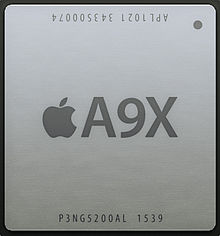
Apple silicon refers to a series of system on a chip (SoC) and system in a package (SiP) processors designed by Apple Inc., mainly using the ARM architecture. They are the basis of Mac, iPhone, iPad, Apple TV, Apple Watch, AirPods, AirTag, HomePod, and Apple Vision Pro devices.

The Apple A6 is a 32-bit package on package (PoP) system on a chip (SoC) designed by Apple Inc. that was introduced on September 12, 2012, at the launch of the iPhone 5. Apple states that it is up to twice as fast and has up to twice the graphics power compared with its predecessor, the Apple A5. Software updates for devices using this chip ceased in 2019, with the release of iOS 10.3.4 on the iPhone 5 as it was discontinued with the release of iOS 11 in 2017.
The Apple A7 is a 64-bit system on a chip (SoC) designed by Apple Inc. It first appeared in the iPhone 5S, which was announced on September 10, 2013, and the iPad Air and iPad Mini 2, which were both announced on October 22, 2013. Apple states that it is up to twice as fast and has up to twice the graphics power compared to its predecessor, the Apple A6. It is the first 64-bit SoC to ship in a consumer smartphone or tablet computer. On March 21, 2017, the iPad mini 2 was discontinued, ending production of A7 chips. The latest software update for systems using this chip was iOS 12.5.7, released on January 23, 2023, as they were discontinued with the release of iOS 13 and iPadOS 13 in 2019.

The Apple M-series coprocessors are motion coprocessors used by Apple Inc. in their mobile devices. First released in 2013, their function is to collect sensor data from integrated accelerometers, gyroscopes and compasses and offload the collecting and processing of sensor data from the main central processing unit (CPU).
The Apple A8 is a 64-bit ARM-based system on a chip (SoC) designed by Apple Inc. It first appeared in the iPhone 6 and iPhone 6 Plus, which were introduced on September 9, 2014. Apple states that it has 25% more CPU performance and 50% more graphics performance while drawing only 50% of the power of its predecessor, the Apple A7. The latest software updates for the 1.1GHz and 1.4GHz variants systems using this chip are iOS 12.5.7, released on January 23, 2023 as they were discontinued with the release of iOS 13 in 2019, and 1.5 GHz variant for the iPad Mini 4 is iPadOS 15.8.2, released on March 5, 2024 as it was discontinued with the release of iPadOS 16 in 2022, while updates for the 1.5 GHz variant continue for Apple TV HD. The A8 chip was discontinued on October 18, 2022, following the discontinuation of the Apple TV HD.

The Apple A8X is a 64-bit ARM-based system on a chip (SoC) designed by Apple Inc. and manufactured by TSMC. It first appeared in the iPad Air 2 and only is used in the iPad Air 2, which was announced on October 16, 2014. It is a variant of the A8 inside the iPhone 6 family of smartphones and Apple states that it has 40% more CPU performance and 2.5 times the graphics performance of its predecessor, the Apple A7. The latest software update for the iPad Air 2 using this chip is iPadOS 15.8.2, released on March 5, 2024, as it was discontinued with the release of iPadOS 16 in 2022 due to hardware limitations of the A8X.

The Apple A9 is a 64-bit ARM-based system-on-chip (SoC), designed by Apple Inc. Manufactured for Apple by both TSMC and Samsung, it first appeared in the iPhone 6S and 6S Plus which were introduced on September 9, 2015. Apple states that it has 70% more CPU performance and 90% more graphics performance compared to its predecessor, the Apple A8. On September 12, 2018, the iPhone 6S and iPhone 6S Plus along with the first-generation iPhone SE was discontinued, ending production of A9 chips. The latest software updates for the iPhone 6S & 6S Plus including the iPhone SE 1st generation variants systems using this chip are iOS 15.8.2, released on March 5, 2024, as they were discontinued with the release of iOS 16 in 2022, and for the iPad 5th generation using this chip was iPadOS 16.7.6, also released on March 5, 2024, as it was discontinued with the release of iPadOS 17 in 2023.

The Apple A10 Fusion is a 64-bit ARM-based system on a chip (SoC), designed by Apple Inc. and manufactured by TSMC. It first appeared in the iPhone 7 and 7 Plus which were introduced on September 7, 2016, and is used in the sixth generation iPad, seventh generation iPad, and seventh generation iPod Touch. The A10 is the first Apple-designed quad-core SoC, with two high-performance cores and two energy-efficient cores. Apple states that it has 40% greater CPU performance and 50% greater graphics performance compared to its predecessor, the Apple A9. The Apple T2 chip is based on the A10. On May 10, 2022, the iPod Touch 7th generation was discontinued, ending production of A10 Fusion chips. The latest software updates for the iPhone 7 & 7 Plus including the iPod Touch 7th generation variants systems using this chip are iOS 15.8.2, released on March 5, 2024, as they were discontinued with the release of iOS 16 in 2022, while updates for the iPad variants systems using this chip are still supported.

The Apple A10X Fusion is a 64-bit ARM-based system on a chip (SoC) designed by Apple Inc. and manufactured by TSMC. It first appeared in the 10.5" iPad Pro and the second-generation 12.9" iPad Pro which were both announced on June 5, 2017. The A10X is a variant of the A10 and Apple claims that it has 30 percent faster CPU performance and 40 percent faster GPU performance than its predecessor, the A9X.

The first generation of iPad Pro is a line of iPad, a tablet computer designed, developed, and marketed by Apple. The iPad Pro was released in 2015 alongside the Apple Pencil, and was the first iPad to use the Pencil as an input device.

The Apple A11 Bionic is a 64-bit ARM-based system on a chip (SoC), designed by Apple Inc. and manufactured by TSMC. It first appeared in the iPhone 8 and 8 Plus, and iPhone X which were introduced on September 12, 2017. Apple states that the two high-performance cores are 25% faster than the Apple A10's and the four high-efficiency cores are up to 70% faster than the two corresponding cores in the A10. The A11 Bionic chip was discontinued on April 15, 2020, following the discontinuation of the iPhone 8 and 8 Plus. The latest software update for the iPhone 8 & 8 Plus and iPhone X using this chip was iOS 16.7.6, released on March 5, 2024, as they were discontinued with the release of iOS 17 in 2023.

The Apple A12 Bionic is a 64-bit ARM-based system on a chip (SoC) designed by Apple Inc. It first appeared in the iPhone XS and XS Max, iPhone XR, iPad Air, iPad Mini, 8th generation iPad and Apple TV 4K. Apple states that the two high-performance cores are 15% faster and 50% more energy-efficient than the Apple A11's, and the four high-efficiency cores use 50% less power than the A11's. It is the first mass-market system on a chip to be built using the 7 nm process.

The Apple A12X Bionic is a 64-bit system on a chip (SoC) designed by Apple Inc. It first appeared in the iPad Pro, announced on October 30, 2018. The A12X is an 8-core variant of the A12 and Apple states that it has 35 percent faster single-core CPU performance and 90 percent faster overall CPU performance than its predecessor, the Apple A10X. The Apple A12Z Bionic is an updated version of the A12X, adding an additional GPU core, and was unveiled on March 18, 2020, as part of the iPad Pro.

The Apple A13 Bionic is a 64-bit ARM-based system on a chip (SoC), designed by Apple Inc. It appears in the iPhone 11, 11 Pro/Pro Max, the 9th generation iPad, the iPhone SE and the Studio Display. Apple states that the two high performance cores are 20% faster with 30% lower power consumption than the Apple A12's, and the four high efficiency cores are 20% faster with 40% lower power consumption than the A12's.

The Apple A14 Bionic is a 64-bit ARMv8.5-A system on a chip (SoC), designed by Apple Inc. It appears in the fourth generation iPad Air and tenth generation iPad, as well as iPhone 12 Mini, iPhone 12, iPhone 12 Pro, and iPhone 12 Pro Max. Apple states that the central processing unit (CPU) performs up to 40% faster than the A12, while the graphics processing unit (GPU) is up to 30% faster than the A12. It also includes a 16-core neural engine and new machine learning matrix accelerators that perform twice and ten times as fast, respectively.

Apple M1 is a series of ARM-based system-on-a-chip (SoC) designed by Apple Inc. as a central processing unit (CPU) and graphics processing unit (GPU) for its Mac desktops and notebooks, and the iPad Pro and iPad Air tablets. The M1 chip initiated Apple's third change to the instruction set architecture used by Macintosh computers, switching from Intel to Apple silicon 14 years after they were switched from PowerPC to Intel, and 26 years after the transition from the original Motorola 68000 series to PowerPC. At the time of introduction in 2020, Apple said that the M1 had the world's fastest CPU core "in low power silicon" and the world's best CPU performance per watt. Its successor, Apple M2, was announced on June 6, 2022, at Worldwide Developers Conference (WWDC).

The Apple A15 Bionic is a 64-bit ARM-based system on a chip (SoC) designed by Apple Inc. It is used in the iPhone 13 and 13 Mini, iPhone 13 Pro and 13 Pro Max, iPad Mini, iPhone SE, iPhone 14 and 14 Plus and Apple TV 4K.

Apple M2 is a series of ARM-based system on a chip (SoC) designed by Apple Inc. as a central processing unit (CPU) and graphics processing unit (GPU) for its Mac desktops and notebooks, the iPad Pro tablet, and the Vision Pro mixed reality headset. It is the second generation of ARM architecture intended for Apple's Mac computers after switching from Intel Core to Apple silicon, succeeding the M1. Apple announced the M2 on June 6, 2022, at Worldwide Developers Conference (WWDC), along with models of the MacBook Air and the 13-inch MacBook Pro using the M2. The M2 is made with TSMC's "Enhanced 5-nanometer technology" N5P process and contains 20 billion transistors, a 25% increase from the M1. Apple claims CPU improvements up to 18% and GPU improvements up to 35% compared to the M1.

The Apple A16 Bionic is a 64-bit ARM-based system on a chip (SoC) designed by Apple Inc. and manufactured by TSMC. It is used in iPhones 14 Pro and 14 Pro Max, and 15 and 15 Plus.
















